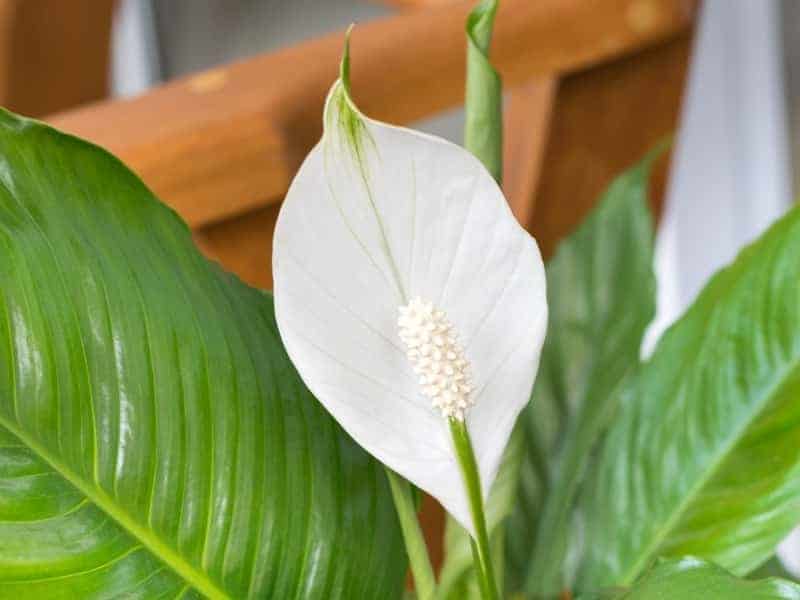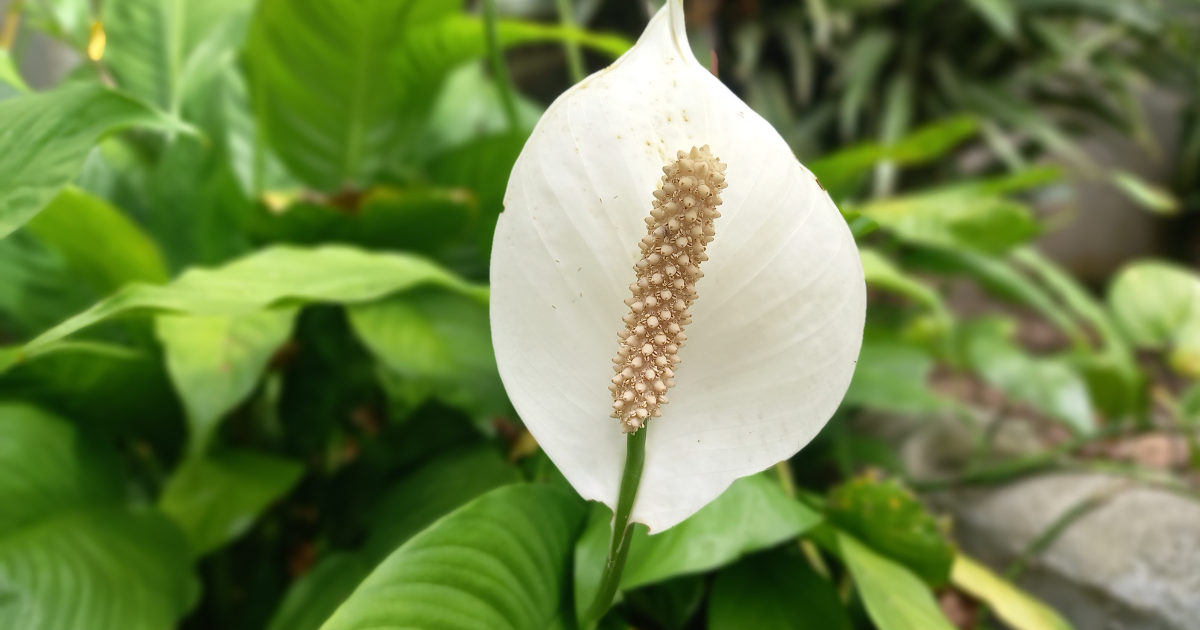People who like to keep plants inside often choose peace lilies, which have beautiful white flowers and lush green leaves. People often ask, “Can peace lily be outside?” The answer isn’t as simple as “yes” or “no,” because it depends on things like the weather, the plant’s environment, and how it’s cared for. We’ll talk about the options and give you important advice in this blog post for people who want to move their peace lily outside.
Peace lilies are a popular houseplant known for their graceful white blooms and dark green leaves. With their tropical origins, peace lilies prefer warm and humid conditions. This leads many homeowners to wonder – can peace lily live outside in winter?
How Cold Tolerant are Peace Lilies?
Peace lilies are not very cold hardy plants. They thrive in temperatures between 65-80°F (18-27°C) and can tolerate down to 50°F (10°C) before suffering damage. Below 50°F, the leaves and flowers will show signs of cold injury. Frost can be very harmful and even fatal to peace lilies.
If temperatures drop below freezing (32°F/0°C) the peace lily will likely die. The cold causes the water in the plant’s cells to freeze and expand rupturing the cell walls. This leads to wilting and black, mushy foliage.
Growing Peace Lilies Outdoors in Winter
Many gardeners wonder if they can keep their peace lily outside over winter. The answer depends on your specific climate.
In subtropical and tropical zones like USDA zones 10-11 peace lilies can remain outdoors year-round. These warm regions rarely see freezing temperatures allowing the peace lily to thrive. Shelter the plant from frost on the occasional cool night.
In temperate climates with cold winters (zones 8-9), it’s best to grow peace lilies in containers. This allows you to move the plant indoors before the first frost. Choose a spot protected from wind and harsh weather. An unheated garage or covered porch works well.
For cold winter zones (4-7), peace lilies cannot survive outdoors. They must be brought inside to a warmer location before freezing weather arrives. A bright window provides adequate light indoors. Avoid drafty areas near doorways.
Protecting Outdoor Peace Lilies in Winter
If you want to keep your peace lily outside as long as possible, there are some techniques to protect it from cold damage:
-
Place containers close to the foundation or against a protected wall. This shields plants from icy winds.
-
Cover the peace lily with frost cloth or burlap when frosty nights are forecast. Remove the cover during the day.
-
Provide supplementary heat with outdoor heat lamps, heating cables, or patio heaters. Maintain temperatures above 50°F.
-
Move potted plants into an unheated garage, shed, or covered porch during cold snaps. This temporary indoor shelter prevents frost damage.
-
Ensure the peace lily enters winter in good health. Avoid repotting or pruning late in the season as this causes stress.
-
Stop fertilizing 6-8 weeks before your first fall frost date. Fertilizing stimulates growth that is more prone to cold damage.
-
Water less frequently once nighttime temperatures drop below 50°F. Excess moisture paired with cold leads to root rot.
Signs of Cold Damage
How can you tell if your peace lily suffered injury from cold temperatures? Watch for these signs:
- Wilting or drooping leaves and flowers
- Leaves and bracts turning brown or black
- Dead, mushy foliage with a foul odor
- Shriveled, dried out leaf tips and margins
- Stunted or aborted flower buds
- Slow growth
If cold damage is mild, the peace lily may recover when moved to warmer conditions. Prune away dead tissue to improve the plant’s appearance. But severe cold stress can be lethal. Discard any plants that fail to revive after several weeks indoors.
Caring for Indoor Peace Lilies in Winter
When growing peace lily as a houseplant over winter, modify your care routine. While most houseplants need more water during hot summer months, scale back on watering peace lilies in winter.
With less sunlight and lower humidity indoors, the soil dries out slower. Only water when the top inch becomes dry. Apply room temperature water, as cold water can shock the roots.
Bright, indirect light from an east or west window is ideal in winter. Turn the plant occasionally to prevent leaning toward the light. Avoid drafty locations near heating and cooling vents.
Mist the leaves regularly or use a pebble tray to boost humidity around the peace lily. The dry indoor air can cause leaf tips to brown without adequate moisture.
Fertilize monthly at half strength while plants are actively growing. Discontinue fertilizer after September to discourage new growth that is vulnerable to chill damage. Resume fertilizing when spring arrives.
Monitor for common peace lily problems like fungus gnats, aphids, and root rot. Isolate any infested plants to prevent pests from spreading. Treat diseases immediately to improve the plant’s vigor before moving it outside.
With proper winter care, a peace lily can spend the cool months flourishing indoors, then move outside again when warmer weather returns. Time the transition for several weeks after the last spring frost to avoid shocking the plant. Gradually introduce to brighter light and more direct sun. Then enjoy your peace lily’s graceful blooms throughout the summer!

Understanding Peace Lily’s Natural Habitat
To fully grasp the needs of a peace lily outside, we should delve deeper into its origins. The peace lily is from the thick, wet undergrowth of tropical rainforests in Central and South America. It is used to living under the trees. This environment provides a unique combination of high humidity, stable temperatures, and indirect sunlight. The nutrient-rich soil is on the forest floor, which is full of dead organic matter. The canopy above blocks the harsh sunlight.
This backdrop is crucial in understanding the peace lilys preferences. It tells us that peace lilies can live indoors, but they are naturally sensitive to the small changes in light and temperature that come with being outside under a canopy.
Assessing Your Local Climate
- When it comes to temperature, peace lilies have a small range of temperatures that they can handle. Even though 65°F to 80°F is the ideal range, it’s important to remember that sudden changes in temperature can be stressful. Peace lilies should be kept inside or given some other way to control the temperature in places where it gets below 60°F at night or during the winter.
- Needs High Humidity: Peace lilies are used to living in rainforests where the humidity is always high. This humidity is very important for their health; it affects everything from the texture of the leaves to the quality of the flowers. In drier climates, creating a micro-humid environment can be beneficial. Putting plants in a humidity tray or grouping them together can help make these conditions more like they are in nature.
- Light: They live in a place with dappled sunlight, which is very different from the harsh sunlight they’ll find outside. If you live in an area that gets a lot of sun, you need to make sure there is shade in the afternoon. A spot that gets soft morning sunlight and afternoon shade would work best.
Can A Peace Lily Live Outside
FAQ
Can I put my peace lily outside on the porch?
How cold is too cold for a peace lily?
How do you keep peace lilies alive in the winter?
Where is the best place to put a peace lily in the winter?
Can peace lilies survive winter?
Temperatures below 40 degrees Fahrenheit will shock their systems and cause wilting, rotting leaves. Even temperatures as mild as 55 degrees can set back a Peace Lily’s development. The ideal range for this plant’s health is from 65 to 85 degrees Fahrenheit. Your Peace Lily can’t survive the winter outdoors unless you’re in a very warm climate.
Can peace lilies grow outside?
As tropical plants, Peace Lilies are sensitive to cold temperatures. You should grow them outdoors only if you live in a suitable hardiness zone. The recommended USDA hardiness zone for Peace Lilies is 10-12. Peace Lilies can be grown in garden soil in tropical areas like Hawaii and Florida.
Can peace lily grow in cold weather?
You must reduce watering and stop fertilizing peace lily in winter. However, gardeners in warmer climates like USDA 10-12 can leave peace lily plant in garden. But, you may or may not see plant growth. As ideal temperature to grow peace lily is 65F to 85F. How Does Cold Weather Affect Peace Lily?
Can peace lilies grow under a canopy?
It tells us that while peace lilies can adapt to indoor environments, they are naturally attuned to the subtle changes in light and temperature that an outdoor setting under a canopy provides. Temperature Tolerance: Peace lilies, being tropical plants, have a narrow comfort zone when it comes to temperature.
How to care for outdoor peace lilies?
Regular inspections for pests and diseases are essential in outdoor environments. Seasonal adjustments in care, especially during summer and winter, are crucial for outdoor peace lilies. Embark on a flourishing journey with plants that aren’t just decor, but companions.
Can peace lilies grow back every year?
Yes, peace lilies can grow back every year. Generally, peace lilies grow well in summer and spring. But in winter, they can’t tolerate freezing temperatures. So, there is a chance that the peace lilies will get frost. But with proper care, the plants might revive again.

